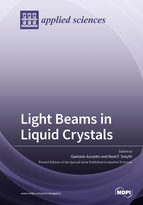Light Beams in Liquid Crystals
A special issue of Applied Sciences (ISSN 2076-3417). This special issue belongs to the section "Optics and Lasers".
Deadline for manuscript submissions: closed (20 May 2021) | Viewed by 12684
Special Issue Editors
Interests: nonlinear optics; nonlinear photonics; optical solitons; nematicons
Special Issue Information
Dear Colleagues,
Welcome to this Special Issue on Light Beams in Liquid Crystals. This Issue is intended to collect current research on the propagation of optical wavepackets in liquid crystals, in either linear or nonlinear regimes. This class of optical media has witnessed a great deal of scientific interest because they possess many intriguing and novel properties in terms of material composition, physical/optical parameters, and microscopic and macroscopic configurations which are a formidable asset towards their use and application in the linear as well as nonlinear optics of light beams propagating in liquid crystals.
We aim to collect papers reporting current work on the propagation and evolution of light beams in liquid crystals, embracing all types of materials and phases falling within this class, including but not limited to thermotropic, chiral, blue-phase, nematic, twisted, lyotropic, uniaxial/biaxial, isotropic/birefringent, etc.
The papers submitted to this Issue should deal with the physics, mathematics, engineering, or material science involved with the propagation and interaction of optical wavepackets in liquid crystals, that is:
- Structured light beam propagation and evolution;
- Optical pulse propagation and evolution;
- Nonlinear-nonlocal optics/photonics;
- Synergy and competition of nonlinear optical responses;
- Beam self-localization and solitary waves;
- Pancharatnam–Berry phase and polarization evolution;
- Random lasing;
- Electro-optical, acousto-optical, thermo-optical, magneto-optical effects with light beams;
- Light modulation/switching;
- Spontaneous/stimulated symmetry breaking;
- Spatio-temporal dynamics;
- Guided-wave optics and applications;
- Light-induced phase transformations;
- Liquid crystal light valves.
Prof. Dr. Gaetano Assanto
Prof. Dr. Noel F. Smyth
Guest Editors
Manuscript Submission Information
Manuscripts should be submitted online at www.mdpi.com by registering and logging in to this website. Once you are registered, click here to go to the submission form. Manuscripts can be submitted until the deadline. All submissions that pass pre-check are peer-reviewed. Accepted papers will be published continuously in the journal (as soon as accepted) and will be listed together on the special issue website. Research articles, review articles as well as short communications are invited. For planned papers, a title and short abstract (about 100 words) can be sent to the Editorial Office for announcement on this website.
Submitted manuscripts should not have been published previously, nor be under consideration for publication elsewhere (except conference proceedings papers). All manuscripts are thoroughly refereed through a single-blind peer-review process. A guide for authors and other relevant information for submission of manuscripts is available on the Instructions for Authors page. Applied Sciences is an international peer-reviewed open access semimonthly journal published by MDPI.
Please visit the Instructions for Authors page before submitting a manuscript. The Article Processing Charge (APC) for publication in this open access journal is 2400 CHF (Swiss Francs). Submitted papers should be well formatted and use good English. Authors may use MDPI's English editing service prior to publication or during author revisions.
Keywords
- Liquid crystals
- Beam optics
- Solitary waves
- Nematicons
- Nonlinear optics
- Nonlocal optics
- All-optical switching
- Guided waves
- Geometric phase
- Optical modulation/switching
- Nonlocal solitons
- Structured beams
- Vortices
- Beam self-localization
- Optical spin-orbit interactions
- Optics of anisotropic media
- Reorientational response
- Thermal response







